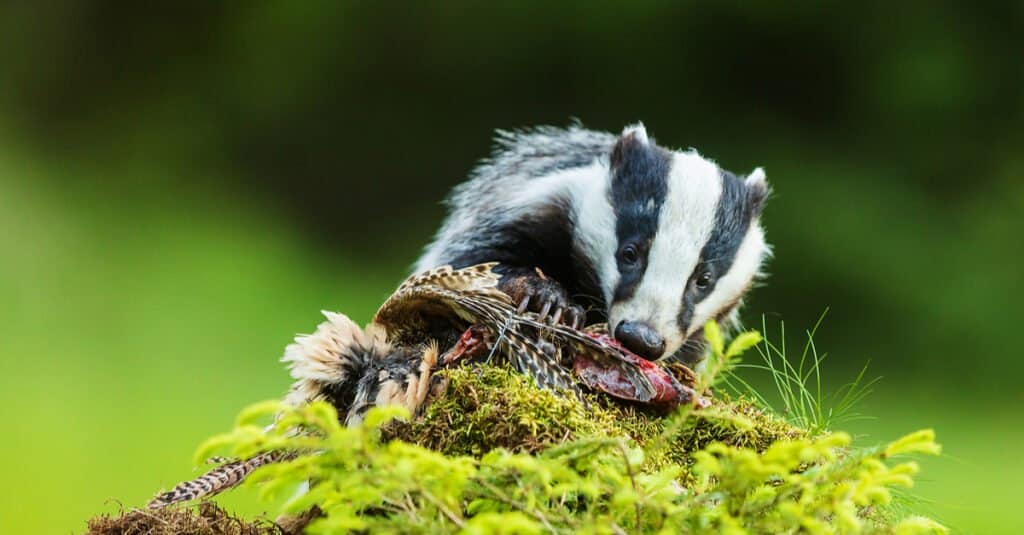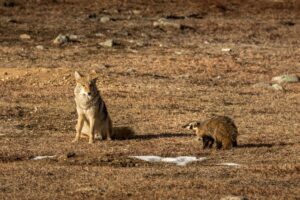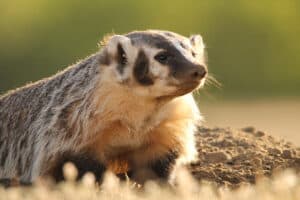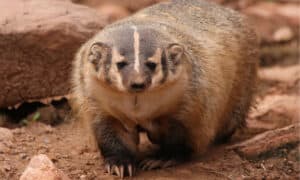The badger has many species and subspecies that possess different and unique characteristics. However, what’s common about them is their resilience and incredible ability to defend themselves against predators, even from large ones like lions and leopards. Badgers have thick fur and loose skin that let them twist and roll around once grabbed by an adversary. Badgers can also emit a foul odor that can throw their opponents or attackers away. On top of that, badgers have sharp claws that they can scratch upon their predators for protection. Another thing badger species all have in common is their dental formula. Badger teeth are incredibly sharp, used in tearing and crushing their prey’s flesh and even bones. Though omnivores, badgers have large, meat-eating carnivore teeth that are not only perfect for hunting but also self-defense.
Badgers can measure from 20 to 34 inches, including the tail. They are often mistaken as skunks because of their similar appearance and ability to release a musky odor to fend off predators. These two mammals, however, are closely related. Badgers live in burrows and are known as tough animals because instead of hiding, they choose to ward off predators, even huge, carnivorous ones. The honey badger, for instance, is notorious for fighting animals such as lions with its long front claws and sharp teeth.
What Kind of Teeth Does a Badger Have?

Badgers have very sharp canine teeth that can easily break tortoise shells.
©Sinisa Botas/Shutterstock.com
All badger species are known for their incredibly sharp teeth that are easily visible whenever they hiss and gnarl. Badgers have a complete set of heterodont teeth composed of medium-sized incisors on the front portion of the mouth, large canines like those of cats and dogs, and flattened premolars and molars, collectively called cheek teeth, that are strong enough to grind the flesh and break the bones of their victims.
Badgers are omnivores that eat a wide range of food. They can feed on soft-bodied animals such as earthworms, grubs, and lizards, and they also eat plant materials like fruits, corn, and legumes. Badgers also prey on small mammals such as rodents, mice, rats, and rabbits. But what’s fascinating about their diet is that it also consists of hard-to-eat animals that most sharp-toothed predators only consume. Badgers can feed on hedgehogs despite the prey’s spiny coat. The honey badger, one of the animals with the toughest skin in nature, can feed on venomous prey such as snakes, scorpions, and even bees. About 25% of the honey badger’s diet is composed of snakes. This diet needs strong teeth to tear the animals into pieces effectively.
The badger’s canine teeth are exceptionally sharp, even though they are not as big as other carnivorous teeth. Their teeth can easily break tortoise shells and crush insects and scorpions’ exoskeletons.
What Do Badgers Use Their Teeth For?

Badgers use their sharp teeth to hunt, kill, and eat their prey.
©Michal Ninger/Shutterstock.com
Badgers use their sharp set of teeth in hunting and killing their prey, eating and crushing their food for easier digestion, and fighting off predators. Although most species of badgers are more fond of soft-bodied invertebrates such as earthworms and insects (which make up about 80% of their diet), their powerful teeth and jaw muscles are strong enough to grab, kill, and crush the flesh and bones of larger animals such as birds, small mammals, and reptiles.
Incisors: Like most mammals equipped with four varying types of teeth that work together for eating and fighting predators, badgers have chisel-like front teeth that are sharp enough to nibble at food. These incisors are often used in their plant-based diet, significantly when cutting fruits from trees. Badgers also use their front teeth often for grooming.
Canines: As omnivores that feed on animal flesh, badgers large and razor-sharp canine teeth are essential. Badgers use these canine teeth in stabbing and killing their prey, especially larger animals like rodents and rabbits. Since badgers are not exclusive meat-eaters, their canines are not as big as other carnivores. When they hiss, badgers display these canines as a threat to predators, attackers, or humans.
Cheek Teeth: The badger’s cheek teeth are composed of premolars and molars. Most carnivores have cheek teeth that have sharp, cutting edges to aid in tearing animal flesh. However, since badgers also feed on plant materials, their molars and premolars have flat crowns to help them grind tough plant food like fruits, corn, and legumes. Though not as sharp, these cheek teeth are tough enough to break the bones of the animals badgers eat. These cheek teeth are also similar to those of humans.
How Many Teeth Does a Badger Have?

A badger has 34 teeth.
©Coatesy/Shutterstock.com
Badgers have 34 teeth, with a dental structure and distribution not far from primates and other mammals. This set of teeth includes three incisors, four sharp canine teeth, three pairs of premolars, and six molars. Badgers typically have a dental formula of incisors 3/3, canines 1/1, premolars 3/3, molars 1/2 = 34, with each number representing the number of teeth on each side of the jaw, top, and bottom.
How Strong is a Badger’s Bite?
The badger’s jaw is surprisingly more powerful than its size suggests. Badgers have a greater bite force quotient than an American black bear. Badgers can generate a 108 BFQ, which is greater than an American black bear with only 64, and a brown bear with 78. The bite force quotient considers the animal’s teeth sharpness and toughness in relation to its body mass.
The badger’s powerful jaws, paired with impressive canines and long, sharp claws reaching 1.5 inches in length, added by a defensive foul odor, help the mammal fight and ward off predators in the wild.
Do Badgers Bite Humans?
Though badgers seem friendly and cute, they can bite humans when hand-held. Hand-feeding badgers are also not recommended as they tend to bite promptly for defense. Badgers have an infamous grumpy nature, and when they bite, they can pierce through the skin and muscles. Since badgers can bite through bones, they can break bones on human fingers and wrists.
The photo featured at the top of this post is © Erwin Niemand/Shutterstock.com
Thank you for reading! Have some feedback for us? Contact the AZ Animals editorial team.







